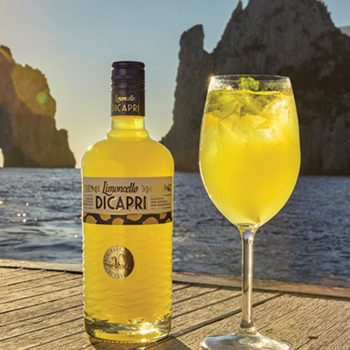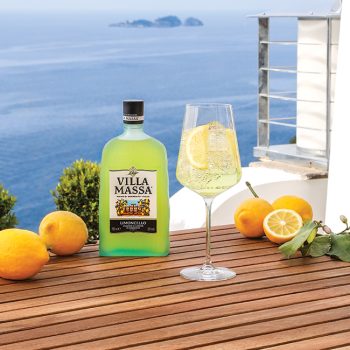How limoncello is putting on the Spritz
The potential for limoncello to move into the big time is huge if brands are able to capitalise on its use in cocktails, and move away from the narrow confines of it being thought of as merely a digestif.

*This feature was originally published in the September 2023 issue of The Spirits Business magazine.
Drinks often make the most sense in the place they were created. A chilled Provence rosé is sublime on a hot summer’s day in the South of France, while a peaty single malt comes into its own on a wind-whipped winter’s night in Scotland. Trying to translate the magic of certain drinks to new settings can be tricky, but they can also act as conduits that transport you back to happy places. Limoncello producers are hoping to do just that by letting imbibers travel through their glass to the sun-drenched shores of the Amalfi Coast.
While still frequently drunk as a digestif in Italy, and as an after-dinner treat at Italian restaurants the world over, limoncello has been enjoying a renaissance, with brands and bartenders recognising its versatility in cocktails and twists on the Spritz serve, thrusting the liqueur out of the after-dinner realm into aperitivo territory. Accounting for 2% of the liqueurs market, global limoncello volume sales rose by 8% between 2021 and 2022, according to IWSR Drinks Market Analysis, with premium-and-above limoncello growing sales by 11% over the same period, buoyed by a strong performance in its homeland and leading export markets such as the US, the UK and Spain.
“Limoncello has become much more international, and has attracted foreign investment in what was previously a predominantly Italian category,” reveals José Luis Hermoso, research director for Central & South America at IWSR. “A decade ago, more than two out of every three bottles of limoncello were being consumed in its home country, while last year 50% of limoncello was exported.”
He cites the reopening of the on-trade after the pandemic as providing a shot in the arm for the category. “The challenge is to maintain this momentum in a difficult economic environment of high inflation and squeezed disposable incomes,” he says. A savvy way to do this, Hermoso believes, is to piggyback on the popularity of the Italian aperitivo phenomenon around the globe, and “surf the Spritz wave to explore new audiences and consumption occasions outside the digestif serve.”
 Leading legacy brands are enjoying a surge in sales, with Bottega posting a 15% spike in sales of its Limoncino brand, and Limoncello di Capri seeing double-digit growth in its major export markets thanks to a particularly strong performance in Scandinavia and Central Europe. Sorrento-based brand Villa Massa, meanwhile, which was acquired by Zamora Company in 2017, enjoyed a “record year” in 2022, growing its sales by 16% and making headway into new export markets such as the Nordics and the Americas.
Leading legacy brands are enjoying a surge in sales, with Bottega posting a 15% spike in sales of its Limoncino brand, and Limoncello di Capri seeing double-digit growth in its major export markets thanks to a particularly strong performance in Scandinavia and Central Europe. Sorrento-based brand Villa Massa, meanwhile, which was acquired by Zamora Company in 2017, enjoyed a “record year” in 2022, growing its sales by 16% and making headway into new export markets such as the Nordics and the Americas.
A new lease of life
In the UK the liqueur is being given a new lease of life through its use in aperitivo cocktails and Spritz serves at venues like Harry’s Bar in Marylebone and in the Big Mamma Group, whose larger-than-life locations include Ave Mario in Covent Garden and Gloria in Shoreditch. “Our organic limoncello sells well across all our restaurants,” says Big Mamma’s group bar manager, Marica Tonucci. “We not only use it as a digestif, but also have it on tap and serve it in one of our most popular drinks – Lo Sgroppino at Jacuzzi and Carlotta – which is made with bergamot sorbet, Italicus liqueur, and limoncello, topped with Champagne. We’ve also twisted it into Spritzes, such as our Limoncello Spritz at Circolo Popolare.”
At the recently renovated Vesper Bar at The Dorchester, bar manager Lucia Montanelli shines a light on limoncello in her twist on a Lemon Drop Martini. “Limoncello shouldn’t be relegated to the digestif category. It’s a very versatile product that can be used as the sweeter component in sour drinks, or as a single ingredient for a Spritz or Collins-style drink,” she says.
The Italian mixologist would like to see more bartenders taking the drink more seriously in cocktails. “I don’t think bartenders in London or Italy are doing enough to get behind limoncello,” she says. “It’s seen as the perfect way to end a meal, but remains very underrated as a valid and versatile cocktail ingredient.”
Federico Pavan, director of mixology at The Donovan Bar in Mayfair, agrees with her. “Using limoncello in ways other than as a digestif is still not common practice, but things are improving. Bartenders should be doing more to promote this amazing liqueur as it is part of the Italian tradition. Connecting legacy limoncello brands with top mixologists would help to grow the category,” he says.
Hindering limoncello’s progress among the global bartending community are the swath of syrupy neon yellow expressions on the market that have very little to do with the real deal from Italy’s Amalfi Coast. “The closest some mainstream limoncellos have come to a lemon is on the label, but craft limoncello is in a different league,” says George Nightingale, founder of Quayside Distillery in Exeter, who recently bottled his first batch of English-made limoncello.
Sandro Bottega, founder and managing director of Bottega, admits that more education is needed to teach consumers the differences between artisan limoncello and the mass-produced examples that have flooded the market. “Limoncello must be promoted as a lifestyle product,” he says. “There are lower-quality limoncellos that are creating problems for the category’s reputation, some of which are made abroad but are branded as Italian products.”
Gareth Franklin, Luxardo’s global brand ambassador, believes history and heritage stand the legacy limoncello brands in good stead, but that misconceptions around the drink still exist. “Liqueurs have been misunderstood for a while because of the use of artificial flavourings and colours in the past,” he says. “Luckily, consumers are more educated than ever, and are looking for brands with integrity. Being a 200-year-old family-owned company helps.”
Flagging up the natural ingredients and artisan practices used in making top-end limoncello is essential if brands want to distance themselves from the tooth-tinglingly sweet mass-market versions. “Like many drinks categories that are enjoying a revival and seeing high levels of demand, there needs to be a focus on ensuring quality,” says Richard Glover, UK brand manager for Limoncello di Capri. “Molinari’s Limoncello di Capri sits in a class of its own, thanks to being made with no additives or preservatives from 100% Sorrento IGP lemons.”
Consumer education
Mario Romano, senior account manager at UK on-trade supplier Speciality Drinks, believes the category-leading brands should be working harder to educate consumers about the provenance of their products and how they are made. “Producers need to talk more about the quality of their ingredients. The companies using real Amalfi/Sorrento lemons should be shouting about this so consumers can understand the quality of the fruit used in the product. There is also a huge opportunity to come up with a more sustainable way of creating limoncello, such as using the entire lemon, and not just the peel,” he says.
 Another challenge facing the category is the lack of brand awareness, which is down to the producers to fix. “Lemon is one of the most loved beverage flavours globally, and we’re seeing limoncello have its place as both an aperitivo and a digestif now,” says Rudy Stol, brand director of Villa Massa. “The challenge is to create a strong, premium brand proposition so it’s not only about the category call, but about consumers showing their preference and creating demand for your brand in particular.”
Another challenge facing the category is the lack of brand awareness, which is down to the producers to fix. “Lemon is one of the most loved beverage flavours globally, and we’re seeing limoncello have its place as both an aperitivo and a digestif now,” says Rudy Stol, brand director of Villa Massa. “The challenge is to create a strong, premium brand proposition so it’s not only about the category call, but about consumers showing their preference and creating demand for your brand in particular.”
One way to do this is via striking packaging that plays on the drink’s Italian roots and the aspirational lifestyle attached to it. “A fresh look and some new bottle designs could benefit the limoncello category, like we’ve recently seen with the amaro category, which has been buoyed by new brands, seeing growth flow to new and old amaros on the market,” says Romano of Speciality Drinks.
Despite these challenges, there is a golden opportunity for limoncello to follow vermouth and amaros, and move into the mainstream. This will need big-name bartenders to get behind it, and brands must work more closely with mixologists. “Producers need to convince bartenders that limoncello is a valid cocktail ingredient,” says Montanelli of the Vesper Bar. “Educating them about the versatility of the product will help them be more confident in using it.”
Limoncello di Capri is helping to make that happen by working with the UK Bartenders Guild to drive awareness in the hospitality sector about the versatility of limoncello.
Limoncello in mixology
Arizona start-up Chelly is also opening up the category to a new audience by working with top mixologists in the US. “We need to promote limoncello as a category that can be used in more frequent serving occasions, such as an apértif, Spritz, and even riffs on traditional cocktails,” says Chelly’s founder, Nick Guerrieri. “We’ve partnered with several mixologists in the US who have created delicious cocktails that you wouldn’t normally think would go with limoncello, such as Tequila, Bourbon, Scotch and mezcal.”
Guerrieri is frustrated by the lack of promotion of the category from the leading Italian brands. “Legacy limoncello brands have not been educating consumers about how versatile the liqueur can be,” he says. “I’ve not seen a festival, event, or expo that has been sponsored by a limoncello brand, which leaves us smaller guys trying to push consumer education,” he says.
Limoncello is at an exciting point in its evolution, and is starting to make a bigger splash in cocktails, breaking free from the confines of the after-dinner serve. But for it to truly cross over, leading brands need to capitalise on their history, heritage, quality ingredients, and artisan production methods. They must tell their stories to the next generation of consumers and bartenders, who can change the category’s fortunes.
A universally loved flavour associated with sunshine and good vibes, in theory limoncello is an easier sell than bitter-sweet aperitivo Aperol, so there’s no reason why the liqueur can’t knock the neon-orange drink off its perch and become the new go-to Spritz at beach clubs and bars around the globe. It just needs some chic brands with cracking packaging to enter the arena, and big-name bartenders to champion it in cocktails.
When life gives you lemons
Keen to offer sun-starved Brits a taste of Italy, English distillers from Cheshire to the Cotswolds have been busy bottling their own small batches of limoncello to capitalise on the growing trend for enjoying the liqueur as an aperitivo. In July, Salcombe Distilling Co in Devon released a limited edition Liquore Citrodora limoncello, which boasts a gin base that’s steeped with lemon verbena, lemon balm, and lemon peel, then is blended with soft Dartmoor water before bottling. Head distiller Jason Nickels was keen to create a sophisticated version of the liqueur that can be enjoyed over ice, mixed with tonic, or used in a cocktail.
“There’s quite a difference between our limoncello and some of the neon varieties on the market. Lowering the ABV in favour of sugar is steering away from tradition towards cost saving. Our higher ABV of 35% means it can be chilled properly in a freezer, while still remaining a liquid,” Nickels says.
Exeter’s Quayside Distillery released three hand-crafted cellos – Limoncello, Limecello, and Naracello (made with oranges) – in the UK in July. The distillery’s owner, George Nightingale, is a long-time limoncello lover who wanted to craft a heavy-hitting expression that didn’t scrimp on flavour. “For many years I’ve wanted to create a limoncello that packs a serious punch. Nothing ever quite lived up to the experiences of limoncello in Italy while on holiday, as the products on the market were quite thin. Seeing the explosion of the Spritz revolution I knew people would be looking for something different, and it just made sense to do it,” says Nightingale, who reveals that the liqueur is proving a hit at his Mediterranean restaurant Spoken in Exmouth. “Since putting it on the cocktail list it’s become a firm favourite. It’s sweet, sour, and great on its own, but also with a meal. I’m hoping people sip it and savour it,” he says.
Related news
Top 10 spirits launches in June
